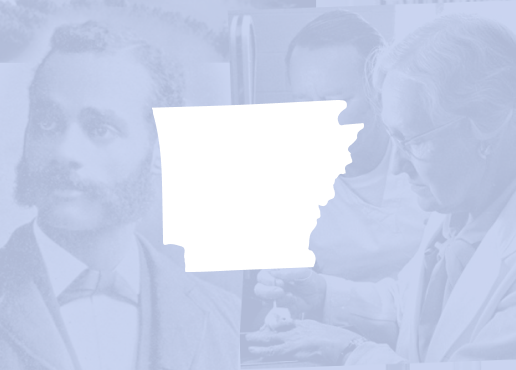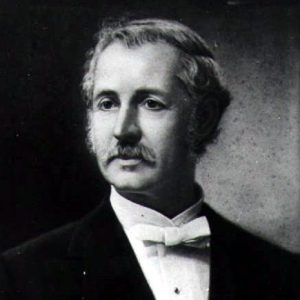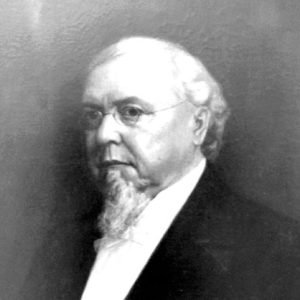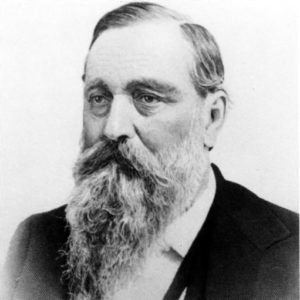calsfoundation@cals.org
Arkansas State Medical Association (ASMA)
The Arkansas State Medical Association (ASMA), organized in 1870, was Arkansas’s first statewide professional organization for regular physicians (meaning those within the regular medical mainstream). A dispute over ethics erupted in 1873, which contributed to the ASMA’s eventual dissolution in 1879.
In nineteenth-century America, regular physicians engaged in professional organizing and advocacy. In 1866, a group of Arkansas’s regular physicians, including Dr. Philo Oliver Hooper of Little Rock (Pulaski County), formed the Little Rock and Pulaski County Medical Society (PCMS). Encouraged by their success, PCMS members looked to establish a state organization for regular physicians.
At a meeting held in Little Rock in 1870, a group of regular physicians organized the Arkansas State Medical Association. The ASMA, whose members were required to be American Medical Association–recognized medical school graduates, would promote not only medical science and ethics but also “fraternity in the medical profession.” Hooper served as the ASMA’s first president.
Despite a promising beginning, ASMA members soon became involved in a divisive dispute regarding ethics. In 1872, Claibourne Watkins of Little Rock, a PCMS and ASMA member, nominated Almon Brooks of Hot Springs (Garland County), a graduate of the University of Virginia medical school, for membership in the PCMS. Hooper challenged Brooks’s membership, citing the fact that he lived outside of Pulaski County. George W. Lawrence and Orlando A. Hobson, both Hot Springs physicians and ASMA members, also challenged Brooks’s membership. (Hobson and Brooks were previously connected; in 1870, the two physicians had lived together in Hot Springs.) Lawrence called Brooks a “professional fraud,” accusing him of committing ethics violations in his patient consultations and prescription-writing.
In response, Brooks presented recommendation letters from other Hot Springs physicians and former governor Henry M. Rector. In 1872, PCMS members voted to admit Brooks into the organization, but the votes fell short of the required two-thirds majority. At a special PCMS meeting held on June 4, 1872, Brooks’s supporters voted unanimously to admit him into the organization. Hooper and Augustus L. Breysacher, who opposed Brooks, attended the meeting but did not vote.
Brooks did not join the PCMS and later co-founded the Hot Springs County Medical Society (HSMS). In January 1873, the Brooks controversy reemerged during the ASMA’s annual meeting. The ASMA credentials committee, led by PCMS member Roscoe G. Jennings, ruled unfavorably upon Brooks’s petition for recognition of the HSMS. In addition, Jennings, Hooper, Breysacher, and others formally protested against the PCMS meeting of June 4, 1872, angering the pro-Brooks PCMS faction. Within the PCMS, Hooper, Jennings, and other anti-Brooks members had had enough. In July 1873, after withdrawing from the PCMS the previous month, they formed a nearly identical county society known as the College of Physicians and Surgeons of Little Rock (CPS).
In October 1873, both PCMS and CPS members attended another ASMA meeting. Brooks again sought recognition of the HSMS. Still unable to resolve their differences concerning Brooks, ASMA members referred the matter to a special judicial committee, composed of Elias R. Duval of Fort Smith (Sebastian County) and two other physicians, to issue a final ruling. Shortly after the meeting, the committee ruled that Brooks had committed ethics violations in his consulting and prescription-writing and recommended against admitting him into the ASMA. Addressing the professional conduct of Brooks’s original accusers, the committee ruled that O. A. Hobson had committed one prescription-related ethical violation and recommended censuring G. W. Lawrence for unethically attacking a fellow physician.
In 1874, despite the special committee’s ruling, the Brooks controversy reemerged during the ASMA’s annual meeting. As the meeting opened, G. W. Lawrence resigned from the ASMA. Disregarding the special committee’s ruling, the ASMA’s credentials committee listed Brooks as a member of the organization. After much debate, the ASMA accepted Brooks’s membership, prompting Breysacher, Hooper, Jennings, Hobson, Duval, and others to resign from the organization. The remaining ASMA members elected Brooks the organization’s second vice president, quickly derailing reconciliation efforts with the seceding members.
In 1875, the former ASMA members organized anew as the Arkansas Medical Society (AMS). Although the ASMA expelled Almon Brooks in 1875, the ASMA and the AMS remained separate organizations until 1879. In that year, the prospect of establishing Arkansas’s first medical school finally prompted the remaining ASMA members to join the AMS. Arkansas’s regular physicians were at last reunited into one professional organization.
For additional information:
“Action of Our Local Society in Regard to Dr. Almon Brooks.” Little Rock Morning Republican, June 8, 1872, p. 4.
Baird, W. David. Medical Education in Arkansas, 1879–1978. Memphis: Memphis State University Press, 1978.
“Proceedings of the Fifth Annual Session of the State Medical Association.” Transactions of the Arkansas Medical Society 5 (1874): 4–12.
“Proceedings of the First Organizational Meeting of the State Medical Association.” Transactions of the Arkansas Medical Society 1 (1870): 1–37.
“Proceedings of the Fourth Annual Session of the State Medical Association.” Transactions of the Arkansas Medical Society 4 (October 1873): 6–26.
“Proceedings the Third Annual Session of the State Medical Association.” Transactions of the Arkansas Medical Society 3 (January 1873): 7–33.
Pulaski County Medical Organizations Minutes. Arkansas State Archives, Little Rock, Arkansas.
Singleton, E. Mitchell. “Hot Springs Physicians and the Formation of the Arkansas Medical Society.” The Record (2012): 65–68.
Melanie K. Welch
Mayflower, Arkansas
 Health and Medicine
Health and Medicine Post-Reconstruction through the Gilded Age, 1875 through 1900
Post-Reconstruction through the Gilded Age, 1875 through 1900 Pulaski County Medical Society
Pulaski County Medical Society Augustus L. Breysacher
Augustus L. Breysacher  Philo Hooper
Philo Hooper  Roscoe Jennings
Roscoe Jennings  Claibourne Watkins
Claibourne Watkins 




Comments
No comments on this entry yet.